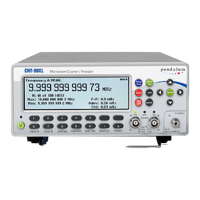Command Reference 8-49
:INPut«[1]|2» :LEVel
8 «<Decimal data>|MAX|MIN»
Fixed Trigger Level
Input A and input B can be individually set to autotrigger or to fixed trigger levels of
between –5 V and +5 V in steps of 2.5 mV. If the attenuator is set to 10X, the
range is –50 V and +50 V in 25 mV steps. Setting an absolute trigger level turns off
autotrigger for the selected channel.
For autotrigger, see the next command.
Parameters: <Decimal data> is a number between –5 V and +5 V if att = 1X and be
-
tween –50 V and +50 V if att = 10X.
+
MAX gives +5 V or +50 V and MIN gives –5 V or -50 V, depending on the
attenuator setting. See above.
Returned format:
<Decimal data>¿
Example for Input A (1)
SEND®
:INP:LEV 8 0.01
Example for Input B (2)
SEND®
:INP2:LEV 8 2.0
*RST condition 0 (but controlled by Autotrigger since AUTO is on after *RST)
:INPut«[1]|2» :LEVel :AUTO
8 «<Boolean> | ONCE»
Autotrigger
If set to AUTO, the counter automatically controls the trigger level.
The autotrigger function normally sets the trigger levels to 50 % of the signal ampli
-
tude. A few exceptions exist, however:
A:
Rise/Fall time measurements: Here the Input 1 (A) trigger level is set to 10% resp.
90% and the Input 2 (B) trigger level is set to 90% resp. 10% of the amplitude.
B:
Frequency and Period Average mode: The input trigger levels are set to 70% re
-
spectively 30% of the amplitude.
C:
Functions for which AUTO does not work are Frequency or Period Back-to-Back,
Time Interval Error (TIE) and Totalize. If one of these is selected, an AUTO ONCE
is performed instead.
ONCE means that the counter makes one automatic calculation of the trigger level
at the beginning of a measurement. This value is then fixed until another
level-setting command is sent to the counter, or until a new measurement is
initiated.

